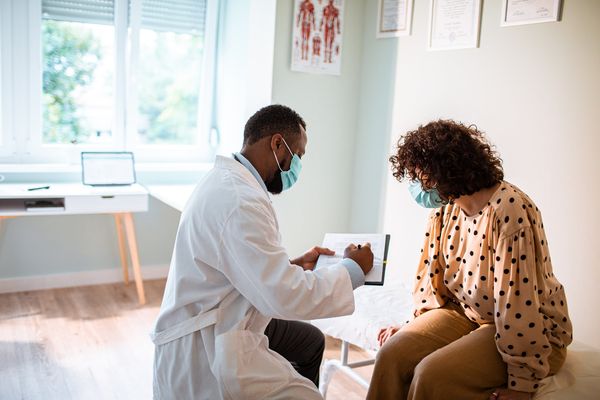From Women's Health Foundation
Do you find that every monthly cycle you're spending more money on tampons and pads than on gas? If so, you may be suffering from a condition called menorrhagia, which is the medical term for excessive or prolonged menstrual bleeding—and for periods that are both heavy and prolonged.
Although each woman is different when it comes to her menstrual cycle, normal menstrual flow should occur every 21 to 35 days and last four to five days, producing a total blood loss that is equivalent to two or three tablespoons.
Learn more about menstrual disorders.
Menorrhagia can interfere with living your life and can lead to anemia. Common signs and symptoms include:
- Menstrual flow that soaks through one or more sanitary pads or tampons every hour for several consecutive hours
- The need to use double sanitary protection to control your menstrual flow
- The need to change sanitary protection during the night
- Menstrual periods that last longer than seven days
- Menstrual flow that includes blood clots as large as or larger than a quarter
- Heavy menstrual flow that interferes with your regular lifestyle
- Constant pain in your lower abdomen during menstrual periods
- Tiredness, fatigue or shortness of breath. These can be symptoms of anemia.
Influences/Causes
Heavy menstrual bleeding can have many causes. Because the causes of menorrhagia vary greatly, it is important to have open and honest communication with your health care professional to accurately diagnose the problem. Common causes may include the following:
- Hormonal imbalance. The hormones estrogen and progesterone normally work together over the course of a normal menstrual cycle to regulate the building up of the endometrium (the lining of the uterus) and its shedding during menstruation. A hormonal imbalance, however, can lead to an excess of endometrium, which, when shed, leads to heavy bleeding. Hormonal imbalances are most common at the beginning and the end of childbearing years—that is, in adolescent girls and women near menopause.
- Thyroid disease. It can lead to hormonal imbalances.
- Uterine fibroids. These non-cancerous (benign) tumors of the uterus can cause heavy or prolonged menstrual bleeding.
- Polyps. Like fibroids, uterine polyps—small benign growths on the lining of the uterine wall—may cause heavy or prolonged menstrual bleeding.
- Intrauterine devices (IUDs). These nonhormonal forms of birth control can cause irritation that leads to cramping and heavy menstrual bleeding. If this is the case, you'll need to have your doctor remove it and find a new birth control method.
- Lack of ovulation. In adolescent girls, as well as women nearing menopause, ovulation may not occur. This is called anovulation, and it can lead to hormonal imbalances that result in menorrhagia.
- Adenomyosis. In this condition, glands from the endometrium (uterine lining) become embedded in the uterine muscle, often causing heavy bleeding and pain. Adenomyosis is most common in middle-aged woman who have had many children.
- Pregnancy complications. You can don't get your period when you're pregnant, but a miscarriage can cause a single, very heavy period. So can an ectopic pregnancy, in which a fertilized egg is implanted in the fallopian tube rather than the uterus.
- Cancer. While rare, a cancer of the uterus, ovaries or cervix can cause excessive menstrual bleeding as a symptom.
- Medications. Certain drugs can bring on heavy or prolonged menstrual bleeding. These include anti-inflammatory medications as well as anticoagulants, which "thin" the blood to prevent blood clots in people with cardiovascular disease.
- Other medical conditions. A number of other medical conditions, including pelvic inflammatory disease (PID), endometriosis, liver or kidney disease or bleeding disorders such as von Willebrand disease, may cause menorrhagia.
Treatments/Remedies
You can take several self-care steps when you have menorrhagia:
- Get plenty of sleep. Excessive bleeding can wake you up during the night, disrupting your sleep schedule. Practice good sleep habits to make sure you can get as much rest as possible.
- Keep a journal. It will help your health care professional determine the amount of bleeding if you jot down the number of pads and tampons you use daily and overnight.
- Stay away from aspirin. Aspirin interferes with blood clotting; avoid it. Instead, use other nonsteroidal anti-inflammatory medications (NSAIDS) such as ibuprofen (Advil, Motrin, others) and naproxen (Aleve ). These can be effective in relieving menstrual discomfort.
- Take folic acid. If you suffer from menorrhagia, you are more likely to become anemic. Taking a folic acid supplement every day may help, as can eating iron-rich foods or taking a multivitamin/multimineral supplement that contains iron. Your health care professional may also prescribe iron supplements.
If you have, or believe you may have, menorrhagia, it's important to make an appointment with your gynecologist. Menorrhagia can sometimes be the symptom of a more serious condition. Your health care professional can determine if underlying medical problems are causing your heavy bleeding.
Treatments for menorrhagia may include:
- Drug therapy. NSAIDS (Advil, Motrin, etc.), oral contraceptives and progesterone are types of drug therapy that can be used to alleviate symptoms of menorrhagia. Iron supplements may also be used if you are suffering from symptoms of anemia as well.
- Surgery. If drug therapy is not successful, there are many surgical procedures. Each has its pros and cons, which you should discuss carefully with your gynecologist. Surgical treatment options include dilation and curettage, aka D&C, in which the cervix is dilated and the lining of the uterus removed; operative hysteroscopy, in which a tiny tube with a light is used to view your uterine cavity and aid in removal of any polyps; endometrial ablation, in which ultrasonic energy is used to destroy the lining of the uterus; and endometrial resection, in which an electrosurgical wire loop is used to remove the lining of the uterus; and finally, hysterectomy, which entails removal of the uterus, cervix and/or ovaries. Back to top
Resources/Contacts
Centers for Disease Control and PreventionMayo ClinicNew York-Presbyterian Hospital
- Heavy Uterine Bleeding and Iron Deficiency Anemia Can Affect ... ›
- Heavy Menstrual Bleeding: Symptoms and Treatment - HealthyWomen ›
- Important Questions to Ask About Heavy Uterine Bleeding and Its Potential Complications: Q & A with Dr. Rashmi Kudesia - HealthyWomen ›
- Heavy Uterine Bleeding and Iron Deficiency Anemia Can Affect Mental Health, Relationships and Sexual Health - HealthyWomen ›
- Why It’s Important to Speak Up About Heavy Uterine Bleeding - HealthyWomen ›
- Heavy Uterine Bleeding May Cause This Potentially Serious Complication - HealthyWomen ›
- Causes of Heavy Periods - HealthyWomen ›
- Talking to Your Health Care Provider about Heavy Periods - HealthyWomen ›
- Normal Periods vs. Irregular Periods - HealthyWomen ›







